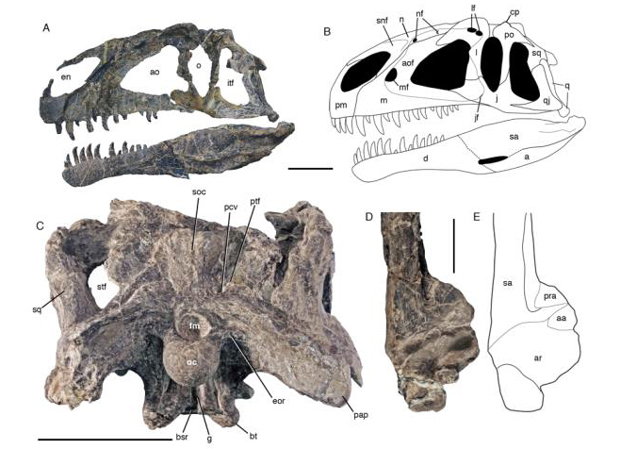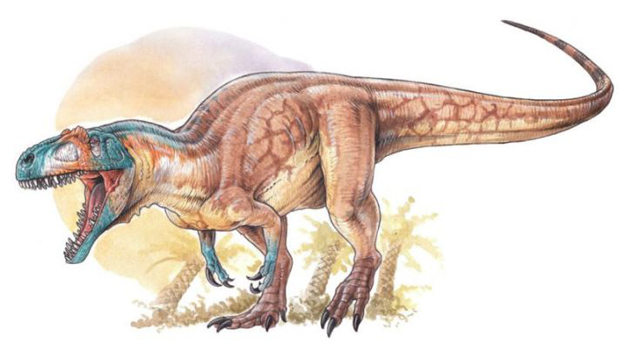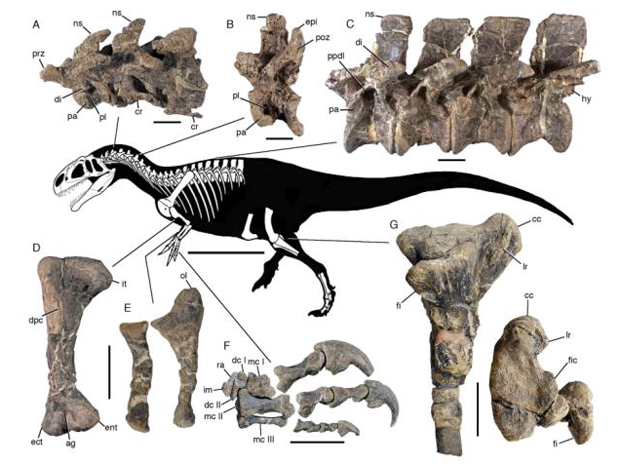A New Basal Allosauroid from Argentina
Asfaltovenator vialidadi – Linking Megalosaurs and Allosaurs
This week has seen the formal publication of a scientific paper announcing the discovery of a new type of meat-eating dinosaur from Chubut Province in the Patagonia of Argentina. This dinosaur named Asfaltovenator vialidadi shows a range of anatomical characteristics which are similar to both Allosaurs and Megalosaurs and whilst it poses a bit of a phylogenetic puzzle when it comes to classifying tetanuran theropods (stiff tails), it does suggest that the Allosauroidea and Megalosauroidea have a common ancestor.
A Life Reconstruction of the Newly Described Asfaltovenator vialidadi
Picture credit: Gabriel Lio/Conicet
Predator of Patagonia Around 175 to 170 Million Years Ago
Discovered back in 2002, from lacustrine deposits (sediments from an ancient lakebed), located about a mile north-east of the village of Cerro Cóndor (Patagonia), the fossil material consists of most of the front portion of the skeleton, including a well-preserved skull. The genus name honours the geological formation from whence it came, the Cañadón Asfalto Formation and the word “venator” from the Latin for hunter. The trivial epithet honours the Administración de Vialidad Provincial of Chubut and the Dirección Nacional de Vialidad, for their help with field expeditions of the Museo Paleontológico Egidio Feruglio.
Dating the deposits associated with the Cañadón Asfalto Formation has proved difficult. Isotope analysis using material from volcanic ash layers has yielded varying results, but in the paper published in the academic journal “Scientific Reports”, the age of the strata associated with this fossil find is stated as late Toarcian to Bajocian, indicating that this predatory dinosaur roamed Gondwana around 175 to 170 million years ago.
Views of the Skull and Jaws of Asfaltovenator with Line Drawings

Picture credit: Scientific Reports
The skull is estimated to be around 80 cm in length and the overall body size of Asfaltovenator is estimated at between seven to eight metres in length.
A Tweak to the Tetanurae
Asfaltovenator demonstrates an unusual combination of anatomical characteristics. Its discovery could have implications for the way in which palaeontologists arrange the family tree of meat-eating dinosaurs.
The Suborder Theropoda, the lizard-hipped, primarily carnivorous dinosaurs, is further divided up into several sub-groups, for example the allosauroids, megalosauroids, ornithomimosaurs, tyrannosauroids, maniraptorans and their close relatives, the birds. Arguably, the most successful part of the Theropoda were the Tetanurae (stiff tails), a clade that is defined as all theropods more closely related to modern birds than to Ceratosaurus. It is thought that the Tetanurae diverged from its sister clade, the Ceratosauria, during the Late Triassic.
Asfaltovenator vialidadi
The discovery of Asfaltovenator is important, as most Middle Jurassic theropods are only known from quite fragmentary material and this dinosaur, described as a basal allosauroid, has traits linking it to both the allosauroids and the megalosauroids.
This suggests that the Allosauroidea and the Megalosauroidea evolved from a common ancestor and that these two parts of the Tetanurae are more closely related to each other than they are to the Coelurosauria, that part of the Tetanurae that gave rise to the tyrannosaurs, ornithomimids, Maniraptora and the birds.
Postcranial Material and a Skeletal Drawing Showing the Known Fossil Material (Asfaltovenator vialidadi)
Picture credit: Scientific Reports
Scientists hope that more large tetanurans can be found in Middle Jurassic strata, as further discoveries will help to hone Theropoda classification.
The Everything Dinosaur website: Everything Dinosaur.



